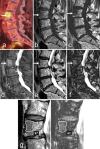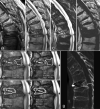Advances in Bone Marrow Imaging: Strengths and Limitations from a Clinical Perspective
- PMID: 36868241
- PMCID: PMC9984270
- DOI: 10.1055/s-0043-1761612
Advances in Bone Marrow Imaging: Strengths and Limitations from a Clinical Perspective
Abstract
Conventional magnetic resonance imaging (MRI) remains the modality of choice to image bone marrow. However, the last few decades have witnessed the emergence and development of novel MRI techniques, such as chemical shift imaging, diffusion-weighted imaging, dynamic contrast-enhanced MRI, and whole-body MRI, as well as spectral computed tomography and nuclear medicine techniques. We summarize the technical bases behind these methods, in relation to the common physiologic and pathologic processes involving the bone marrow. We present the strengths and limitations of these imaging methods and consider their added value compared with conventional imaging in assessing non-neoplastic disorders like septic, rheumatologic, traumatic, and metabolic conditions. The potential usefulness of these methods to differentiate between benign and malignant bone marrow lesions is discussed. Finally, we consider the limitations hampering a more widespread use of these techniques in clinical practice.
The Author(s). This is an open access article published by Thieme under the terms of the Creative Commons Attribution-NonDerivative-NonCommercial License, permitting copying and reproduction so long as the original work is given appropriate credit. Contents may not be used for commercial purposes, or adapted, remixed, transformed or built upon. (https://creativecommons.org/licenses/by-nc-nd/4.0/).
Conflict of interest statement
None declared.
Figures










References
-
- Geith T, Schmidt G, Biffar A. Comparison of qualitative and quantitative evaluation of diffusion-weighted MRI and chemical-shift imaging in the differentiation of benign and malignant vertebral body fractures. AJR Am J Roentgenol. 2012;199(05):1083–1092. - PubMed
-
- Zajick D C, Jr, Morrison W B, Schweitzer M E, Parellada J A, Carrino J A. Benign and malignant processes: normal values and differentiation with chemical shift MR imaging in vertebral marrow. Radiology. 2005;237(02):590–596. - PubMed
-
- Schmeel F C, Luetkens J A, Wagenhäuser P J. Proton density fat fraction (PDFF) MRI for differentiation of benign and malignant vertebral lesions. Eur Radiol. 2018;28(06):2397–2405. - PubMed
-
- Kirchgesner T, Perlepe V, Michoux N, Larbi A, Vande Berg B. Fat suppression at 2D MR imaging of the hands: Dixon method versus CHESS technique and STIR sequence. Eur J Radiol. 2017;89:40–46. - PubMed

